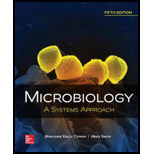
Microbiology: A Systems Approach
5th Edition
ISBN: 9781259706615
Author: Marjorie Kelly Cowan Professor
Publisher: McGraw-Hill Education
expand_more
expand_more
format_list_bulleted
Question
Chapter 19, Problem 10MCQ
Summary Introduction
Introduction:
Microorganisms are small microscopic living organisms which are so small that they cannot be seen with unaided eyes. Viruses, bacteria,
Expert Solution & Answer
Want to see the full answer?
Check out a sample textbook solution
Students have asked these similar questions
students in a science class investiged the conditions under which corn seeds would germinate most successfully. BAsed on the results which of these factors appears most important for successful corn seed germination.
I want to write the given physician orders in the kardex form
Amino
Acid Coclow
TABle
3'
Gly
Phe
Leu
(G)
(F) (L)
3-
Val
(V)
Arg (R)
Ser (S)
Ala
(A)
Lys (K)
CAG
G
Glu
Asp (E)
(D)
Ser
(S)
CCCAGUCAGUCAGUCAG
0204
C
U
A G
C
Asn
(N)
G
4
A
AGU
C
GU
(5)
AC
C
UGA
A
G5
C
CUGACUGACUGACUGAC
Thr
(T)
Met (M)
lle
£€
(1)
U
4
G
Tyr
Σε
(Y)
U
Cys (C)
C
A
G
Trp (W) 3'
U
C
A
Leu
בוט
His
Pro
(P)
££
(H)
Gin
(Q)
Arg
흐름
(R)
(L)
Start
Stop
8. Transcription and Translation Practice: (Video 10-1 and 10-2)
A. Below is the sense strand of a DNA gene. Using the sense strand, create the antisense
DNA strand and label the 5' and 3' ends.
B. Use the antisense strand that you create in part A as a template to create the mRNA
transcript of the gene and label the 5' and 3' ends.
C. Translate the mRNA you produced in part B into the polypeptide sequence making sure
to follow all the rules of translation.
5'-AGCATGACTAATAGTTGTTGAGCTGTC-3' (sense strand)
4
Chapter 19 Solutions
Microbiology: A Systems Approach
Ch. 19.1 - Describe the important anatomical features of the...Ch. 19.1 - Prob. 2AYPCh. 19.2 - Discuss the current state of knowledge regarding...Ch. 19.3 - Prob. 4AYPCh. 19.3 - Prob. 5AYPCh. 19.3 - Discuss important features of meningoencephalitis,...Ch. 19.3 - Prob. 7AYPCh. 19.3 - Prob. 8AYPCh. 19.3 - Prob. 9AYPCh. 19.3 - Prob. 10AYP
Ch. 19 - Prob. 1MCQCh. 19 - Prob. 2MCQCh. 19 - Meningococcal meningitis is caused by a....Ch. 19 - Prob. 4MCQCh. 19 - Prob. 5MCQCh. 19 - Prob. 6MCQCh. 19 - Prob. 7MCQCh. 19 - Prob. 8MCQCh. 19 - Prob. 9MCQCh. 19 - Prob. 10MCQCh. 19 - Prob. 11TFCh. 19 - Prob. 12TFCh. 19 - Prob. 13TFCh. 19 - Prob. 14TFCh. 19 - Prob. 15TFCh. 19 - Prob. 1CTQCh. 19 - Prob. 2CTQCh. 19 - Prob. 3CTQCh. 19 - Prob. 4CTQCh. 19 - Prob. 5CTQCh. 19 - Prob. 1VCCh. 19 - Prob. 1CM
Knowledge Booster
Learn more about
Need a deep-dive on the concept behind this application? Look no further. Learn more about this topic, biology and related others by exploring similar questions and additional content below.Similar questions
- What is the structure and function of Eukaryotic cells, including their organelles? How are Eukaryotic cells different than Prokaryotic cells, in terms of evolution which form of the cell might have came first? How do Eukaryotic cells become malignant (cancerous)?arrow_forwardWhat are the roles of DNA and proteins inside of the cell? What are the building blocks or molecular components of the DNA and proteins? How are proteins produced within the cell? What connection is there between DNA, proteins, and the cell cycle? What is the relationship between DNA, proteins, and Cancer?arrow_forwardWhy cells go through various types of cell division and how eukaryotic cells control cell growth through the cell cycle control system?arrow_forward
- In one paragraph show how atoms and they're structure are related to the structure of dna and proteins. Talk about what atoms are. what they're made of, why chemical bonding is important to DNA?arrow_forwardWhat are the structure and properties of atoms and chemical bonds (especially how they relate to DNA and proteins).arrow_forwardThe Sentinel Cell: Nature’s Answer to Cancer?arrow_forward
- Molecular Biology Question You are working to characterize a novel protein in mice. Analysis shows that high levels of the primary transcript that codes for this protein are found in tissue from the brain, muscle, liver, and pancreas. However, an antibody that recognizes the C-terminal portion of the protein indicates that the protein is present in brain, muscle, and liver, but not in the pancreas. What is the most likely explanation for this result?arrow_forwardMolecular Biology Explain/discuss how “slow stop” and “quick/fast stop” mutants wereused to identify different protein involved in DNA replication in E. coli.arrow_forwardMolecular Biology Question A gene that codes for a protein was removed from a eukaryotic cell and inserted into a prokaryotic cell. Although the gene was successfully transcribed and translated, it produced a different protein than it produced in the eukaryotic cell. What is the most likely explanation?arrow_forward
arrow_back_ios
SEE MORE QUESTIONS
arrow_forward_ios
Recommended textbooks for you
- Essentials of Pharmacology for Health ProfessionsNursingISBN:9781305441620Author:WOODROWPublisher:Cengage
 Comprehensive Medical Assisting: Administrative a...NursingISBN:9781305964792Author:Wilburta Q. Lindh, Carol D. Tamparo, Barbara M. Dahl, Julie Morris, Cindy CorreaPublisher:Cengage Learning
Comprehensive Medical Assisting: Administrative a...NursingISBN:9781305964792Author:Wilburta Q. Lindh, Carol D. Tamparo, Barbara M. Dahl, Julie Morris, Cindy CorreaPublisher:Cengage Learning Medical Terminology for Health Professions, Spira...Health & NutritionISBN:9781305634350Author:Ann Ehrlich, Carol L. Schroeder, Laura Ehrlich, Katrina A. SchroederPublisher:Cengage Learning
Medical Terminology for Health Professions, Spira...Health & NutritionISBN:9781305634350Author:Ann Ehrlich, Carol L. Schroeder, Laura Ehrlich, Katrina A. SchroederPublisher:Cengage Learning 

Essentials of Pharmacology for Health Professions
Nursing
ISBN:9781305441620
Author:WOODROW
Publisher:Cengage

Comprehensive Medical Assisting: Administrative a...
Nursing
ISBN:9781305964792
Author:Wilburta Q. Lindh, Carol D. Tamparo, Barbara M. Dahl, Julie Morris, Cindy Correa
Publisher:Cengage Learning

Medical Terminology for Health Professions, Spira...
Health & Nutrition
ISBN:9781305634350
Author:Ann Ehrlich, Carol L. Schroeder, Laura Ehrlich, Katrina A. Schroeder
Publisher:Cengage Learning



Bacterial Infections in Humans; Author: Professor Dave Explains;https://www.youtube.com/watch?v=FeFKAl9KyMg;License: Standard Youtube License